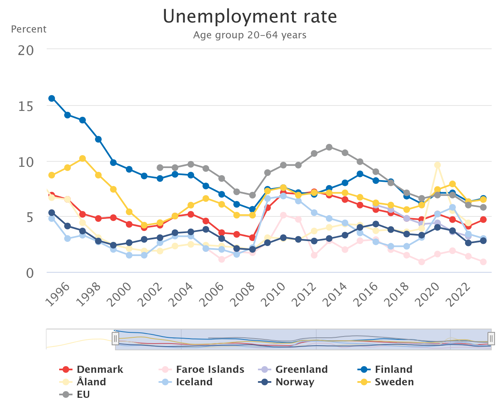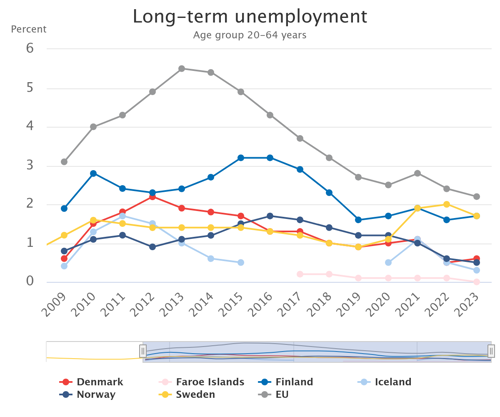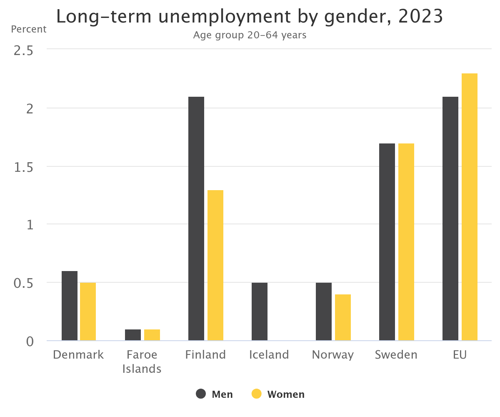Long-term unemployment in the Nordics
During 2023, long-term unemployment decreased in four of six Nordic countries , Faroe Islands, Iceland, Norway and Sweden. The first two also reported decreases in general unemployment, while the two latter reported increases in general unemployment. The two countries with increases in long-term unemployment, Denmark and Finland, also reported increases in general unemployment. No Nordic country reports higher rates for women.
Long-term unemployment causes significant mental and material stress for those affected and their families. It is also of particular concern for policy makers, as high rates of long-term unemployment indicate that labour markets are operating inefficiently. [1] The probability of getting a job decreases with time in unemployment and the job chance also decreases with age. [2]
Unemployment
The total unemployment rate [3] in a country is closely connected to the long-term unemployment rate. In the Figure below, the total unemployment rate in all eight Nordic countries and the EU, from 1996 and onwards, is visualised.

Source: Nordic Statistics Database, WORK02
Most of the Nordic countries experienced decreases in their unemployment rates from 1996 up until the financial crisis in 2008/2009. From 2008 to 2009, all Nordic countries and the EU witnessed an increase in unemployment. In some countries, such as the Faroe Islands, the effect of the financial crisis seems to have been delayed. The self-governing island reported a minor increase in 2009, and the full effect of the crisis became evident first in 2010. During this period, the largest increase from one year to another was reported in Iceland, the unemployment rate in the country rose from 2.2 to 6.6 between the years of 2008 and 2009.
A similar pattern can be seen in 2020 and 2021, i.e. during the pandemic. During this period, all the Nordic countries and the EU witnessed increases in unemployment rates. The rates have since decreased, but noteworthy is that four countries (Denmark, Finland, Norway and Sweden) report increases in 2023 as well. For Greenland and Åland, 2023 values are not yet available.
Finally, the average unemployment rate has been higher in the EU than in the Nordic countries during most of the period. In the last years however, the unemployment rate in the EU has declined to rates comparable with those of Sweden and Finland.
Long term unemployment
Long-term unemployment [3,4,5] is defined as an unemployed person who have been so for one year or more. The duration of unemployment is the duration of the search for employment or the length of the period since the person last worked; whichever period is shorter.
Since a high rate would indicate that the labour market of a country is not operating efficiently, this statistic is closely monitored by policy makers.
In the Figure below, the long-term unemployment in six of the eight Nordic countries, from 2009 and onwards, is visualised. Please note that no data is available for Greenland or Åland, and that the definition differs for Faroe Islands. [4,5]

Source: Nordic Statistics Database, LABO13
The EU has a higher long-term unemployment rate than all Nordic countries during the period.
In the last three years, 2021 to 2023, there seems to be two groupings of countries. Sweden and Finland can be found together, whereas Denmark, Iceland, and Norway can be seen sharing a slightly lower rate. Before 2021, Finland was alone at a higher rate than the rest of the Nordic countries. The rate for Faroe Islands stands out as very low.
For some of the countries, especially Sweden and Iceland, a rise in long-term unemployment could be seen during the pandemic, and it has not come down to pre-pandemic levels. Sweden reports that a significant part of the increase occurred among foreign born, and especially among foreign born women. Long-term unemployed who get employed tend to go into service occupations and the majority get temporary employment.[2]
Gender differences
Looking at the long-term unemployment rate by gender in 2023, it is higher for men in three of the countries for which data is available, Denmark, Finland and Norway. In Faroe Islands and Sweden, there are no visible differences between men and women. Please note that the rate for Icelandic women in 2023 is not available.

Source: Nordic Statistics Database, LABO13
Seen over time, the rate for Finnish men has constantly been higher than that of Finnish women. A similar pattern can be observed for both Sweden and Norway, where men have had a higher rate most years. In Demark the gender balance has varied, and as for the Faroe Islands, the gender difference has been quite small over time.
For the EU, the rate is higher among women in 2023, as it has been every year since 2009.
_______________________________________________________________________
[1] https://www.oecd.org/en/data/indicators/long-term-unemployment-rate.html
[3] For Denmark, Finland, Iceland, Norway and Sweden, data is collected from the Labour Force Survey (LFS) which is an inquiry directed to households, designed to obtain information on the labour market and related issues through a series of personal interviews.
[4] No data on long term unemployment is available for Greenland or Åland, but values for Åland are included in values for Finland.
[5] For Faroe Islands, values cover ages 16-66 years and are based on administration registers of Unemployment Insurance and Social Security. The annual values are calculated as averages of the monthly values presented at Statistics Faroe Islands.